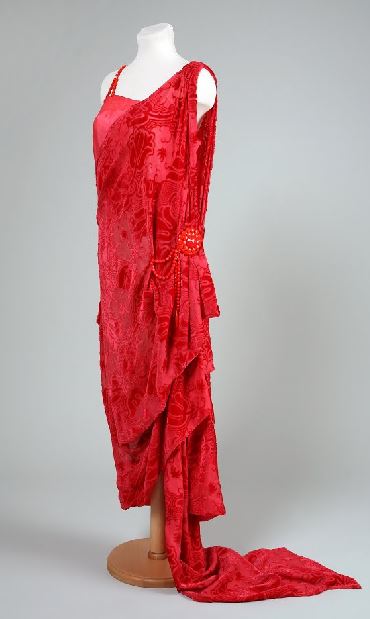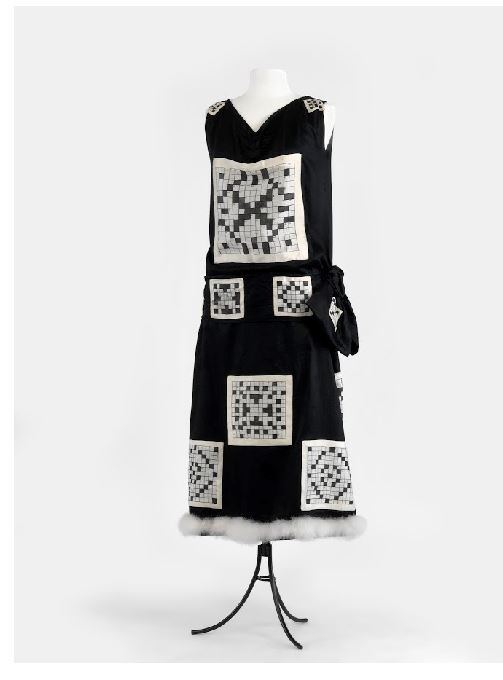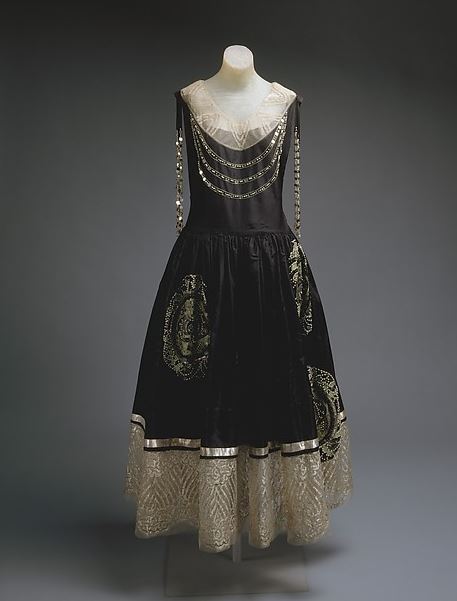
Lanvin robe de style, 1924 http://www.metmuseum.org/art/collection/search/81462?sortBy=Relevance&deptids=8&ao=on&ft=pastes&offset=0&rpp=100&pos=60
$35,000 a Year to Dress a “Deb”!
Dressmakers to the “400” Tell How the Modern Society Girl Wears Annually 30 Evening Gowns, 250 Pairs of Stockings, 25 Pairs of Shoes, 30 Hats, 2 Dozen Negligees, 1 Dozen Evening Wraps, and a $25,000 Coat!
When one of New York’s smartest dressmakers announced the other day that nobody could dress on less than $35,000 in a year, a lot of people clutched their pocketbook with one hand and held up the other hand in horror.
But not the debutante. Not, either, the debutante’s mother in the his year of grace 1924. Nor, indeed, the debutante’s father. They knew that the dressmaker’s estimate was conservative. “I only hope my daughter will cut her wardrobe expenses down to $35,000!” was the sincere groan of many a plutocratic parent.
Of course when the dressmaker said nobody could dress on less than $35,000 a year, she referred to anybody feminine who was “anybody” in New York City. Even in Manhattan there are girls who spend less than $500 a year for clothes. But they are not the girls who get their names into the society column.
To the innocent bystander, however, whose name never gets near the society column than the death notices, advertisements and “marriage licenses issued today,” that $35,000 remark was a smash between the eyes. “How,” said the innocent bystander, fingering his last $1 bill, “can any woman not only not get along on less than $35,000 for clothes and incidentals alone—but how, on clothes and incidentals alone, can she spend so much?”
The easiest answer is: “Easily.” But after all, that doesn’t tell the innocent bystander much about what it’s all for, so this innocent bystander galumphed up to the source of the hair-raising remark and asked how come, with specifications, explanations and itemized particulars.

Miss Fay Lewisohn
She’s a surprisingly young and girlish person, this Fay Lewisohn who made the statement which has ever since been causing squawk of dismay. Perhaps it is worth noting that the squawks come from people—like oneself, for example—who haven’t anything like $35,000 to spend on anything, let alone on clothes. Her establishment is in the most fashionable-dressmaker section of West Fifty-seventh street, which as the initiate know is at present the ultra fashionable district for the modistes whose clientele is truly exclusive.
“How can a woman spend $35,000 a year on dress?” is the question directed at the slim, attractive young woman who announces herself as proprietor of the place.
The slim, attractive young woman shrugged. “How can she help it?” is her answer.
“Well, but after all—”
The modiste smiled. “Oh, I’m talking about the woman of wealth and social position. Naturally, every one who comes to my shop for an occasional gown doesn’t spend that much on clothes; perhaps not in a lifetime. I myself don’t spend that much on clothes in a year.
“But perhaps you don’t realize that there are dozens of women in New York today to whom $35,000 as an annual outlay for dress, cosmetics and so on, is not an extravagance. I know one woman who has a yearly contract with a modiste for $50,000 worth of clothes. There are society women who easily spend that much. Just as there are people who spend $50 a month for a house and others who pay $15,000 a year for an apartment. The thing is relative, you know.”
The modiste, it seemed, got a fair profit and no more. “It is possible that by some lucky chance a woman might find a cheap dressmaker who would turn her out, as well as one whose prices were higher. That is an unlikely chance; but it might happen. However, what the society woman wants is a quiet, attractive place in which to inspect gowns. She wants to see those gowns displayed by refined, high-class models. Naturally, both these requisites mean high rent and good salaries.”
Your murmur about the overhead expense brought an emphatic nod.
“Moreover, the very materials in the clothes themselves are expensive even before the scissors and needle touch the goods. Brocades at, say, around $100 a yard, send the price of a gown up, rather.”
Rather!
“There is an East Indian, for example, who brings me marvelously embroidered silks straight from India. He drapes them around the models and they really need, oftentimes, very little cutting or sewing. But the materials themselves are almost museum pieces. Some are antiques. And, of course, they are very valuable.
“Another big item in sending up the price of a frock is the actual labor upon it. Labor I these days and in this city, especially skilled needlework, is high. On a first-class gown which has many yards of an intricately beaded pattern, each bead must be sewn on with care so that it won’t pull off. These patterns often are works of art and it requires almost artists to bead them. Do you know that the beading on one gown, when properly done, may take several weeks?”
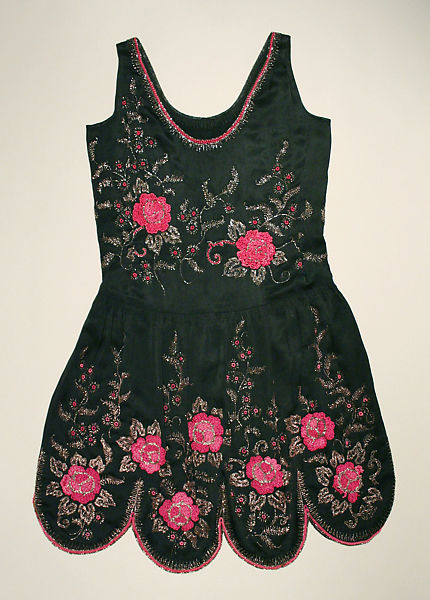
1924 flapper dress beaded with hot-pink roses. https://www.metmuseum.org/art/collection/search/99694?searchField=All&sortBy=relevance&deptids=62%7c8&ft=evening+dress&offset=60&rpp=20&pos=61
These were matters worthy of consideration. But how many of these gowns would a sure-enough social leader need in the course of a year? And how much would such a gown cost?
It depended, naturally, on the taste of the patron and the amount of beading.
“A gown of this type, beautifully done, might run into many hundreds of dollars. It might be five hundred dollars, six hundred—the material itself would, of course, be a determining factor. I am speaking, by the way, of a gown on which the modiste would make a legitimate profit; not of a gown for which the modiste would charge every dollar she thought she could extort.
“A debutante may easily spend $35,000 a year for clothes and really get her money’s worth. Without being cheated by the modiste.”
You began to see how this was so.
“Now, for instance,” the modiste continued, “a girl who moves in what is known as high society needs about thirty evening gowns. She doesn’t plan to wear any costume more than two or three times; some of them only once. It is not too much to say that thirty evening gowns would cost her $9000.
“She would require 250 pairs of stockings. These would cost on a average, perhaps $9 a pair; an item of $2250 for hosiery alone. Of course, some stockings would cost much more than $9 a pair.”
As a matter of fact, a shop in the vicinity of Fifth avenue and Forty-second street has had on display within the year a pair of stockings priced at $500. Not $500 each, you understand; but $500 for the pair, or $250 each. They were perfectly simple black silk hose, with a large medallion of lace on the front.
The same shop had another pair of quite good-looking silk and lace stockings for $250.
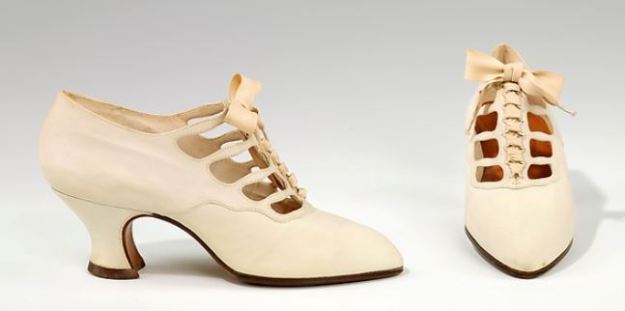
Yantorny shoes, c. 1925-30 http://www.metmuseum.org/art/collection/search/156937?sortBy=Relevance&deptids=8&ao=on&ft=shoes&pg=2&rpp=20&pos=21
But the modiste was going on with her itemized bill of wardrobe expenses. Shoes, she agreed, could cost anything you want to spend on them, but $2000 wasn’t too much for some women. A lady who wanted her feet to look really chic would require, at the least twenty-five pairs of shoes, and this was a low estimate.
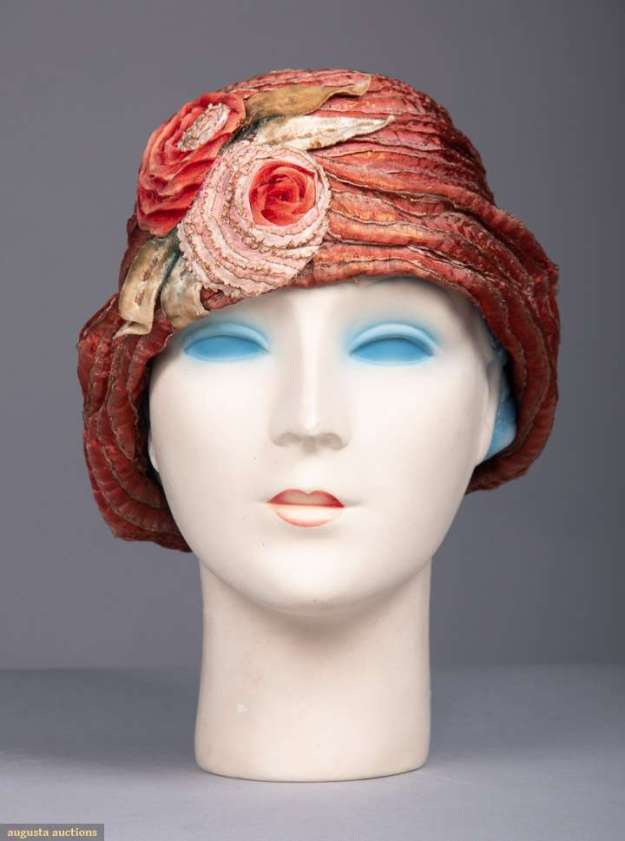
Cloche with ombre ribbonwork, c. 1925 https://augusta-auction.com/list-of-upcoming-sales?view=lot&id=19406&auction_file_id=55
Hats? Of course, you could get a good little hat for $35. Or you could get a stunning little thing for $100. Anyway, the lady would need at least thirty hats and she could easily spend from $1200 to $2100 before she got out of the millinery department.
By this time you begin to see that milady has run up quite a sizable bill. But the end is by no means yet. How about lingerie? How about lounging robes for the boudoir? How about the perfumes and powders, the creams and other cosmetics with which the boudoir dressing table is stacked?
Of course, a negligee is whatever you please. It is, so to speak, an elastic garment. It may be a cotton wrapper or a thing exquisite as sunshine on the sea. The negligee of the social leader is of this latter type. And you’d be surprised at how expensive it is to put the sunshine on the sea into figured silk and chiffon.
“A dozen negligees are not too many” –it is the voice of authority which speaks; “many women have many more than a dozen. They might easily cost a little more than $200 apiece, or $2500 for the dozen.
“As for lingerie—I have just finished a set of lingerie, for a bride, which is valued at $10,000. I have made other sets for $15,000; that is to say, a dozen of each garment. The set which I have just finished was of hand-made filet lace and Italian silk of special quality. The wedding gown, priced at $600, was intricately beaded with crystal. One could get a really lovely wedding gown, as a matter of fact for around $300. But, of course, this is without the veil. The veil may cost as much as one is willing to pay—
“It may be a few almost priceless yards of antique lace, made in some convent of the Middle Ages.
“The more usual lingerie, of finest linen or silks and exquisite laces, would cost about $3600 for two dozen sets.
“A dozen evening wraps would be part of the society woman’s wardrobe. It is difficult to put a price on them. They might cost several hundred dollars each, depending on what fur was used for the collars and other decorations.
“There are such things as fans, too, which vary tremendously in price. These would mount at least into the hundreds. Corsets, too, are expensive when well made and made to order. The materials are costly, also. Seventy dollars is the price of one corset which makes no pretense to embroidery or other ornamentation. The price is for the best quality of brocade and of silk elastic and for the model itself.
“You understand, further that a social leader could not possibly buy her furs within that $35,000 which I have allowed her for a wardrobe. Furs would have to be extra. For a handsome coat $15,000 is not an unusual price and $25,00 would more likely be the figure.
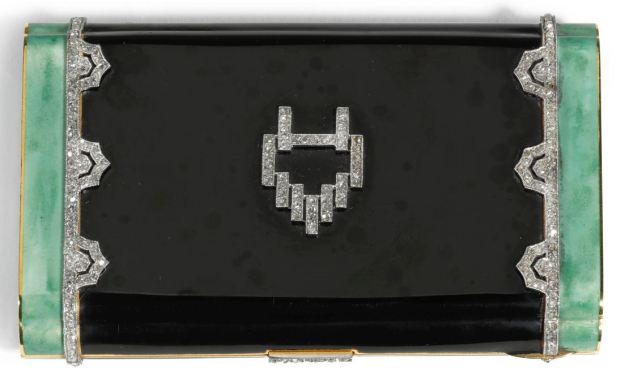
Cigarette case, c. 1920 http://www.sothebys.com/en/auctions/ecatalogue/2018/from-earth-to-fire-l18302/lot.808.html
“This leaves what are known as incidentals. They include hairdressing and all that goes with this art; beauty treatments, with cosmetics, perfumes at—say–$30 an ounce—and things of the sort. Cigarettes, too, may be put with the incidentals. Many society women smoke the brands that come in fifteen or twenty cent packages, but you may, if you wish, have the sort that has a monogram, a special blend of tobacco and a little dab of cotton inside the cork tip to absorb the nicotine and keep it from touching the lips. Without the monogram these can be obtained for around eleven cents each.
“No, not each packet. Each cigarette.
“For incidentals we may safety estimate that a society woman spends $5000 yearly.”
The modiste drew a long breath. So did you.
“Well, you see,” she said.
You did, indeed.
New Britain [CT] Herald 7 October 1924: p. 16
Mrs Daffodil’s Aide-memoire: Mrs Daffodil, who has previously shared information on the account-books of the very rich (The Cost of a Fine Lady, What Gilded Youth Spends on Its Wardrobe, Where that $10,000 a Year Dress Allowance Goes, and The Cost of a Curtsey), wonders if these articles are a form of what she has heard called “humble-bragging,” or if they are meant to be inspiration for the ten-shillings-a-week shop-girl to set her sights on an elderly peer or millionaire?
Although she inexplicably omits essentials such as hand-bags, vanity cases, and jewels, Miss Lewisohn knew a thing or two about the sartorial needs of the society woman. She was the heiress to the Randolph Guggenheim millions. She was often in the news: Her engagement to one William Burton (of a Park Avenue address) was announced 23 February 1919; the engagement was reported as broken on 2 April, 1919, with her mother saying that the couple was “Too young to know their own hearts.” In 1921 she had to issue a statement denying that she was marrying a Russian prince; while in 1922, she announced the opening of her dressmaking establishment, in partnership with Mrs. Basil Soldatenkov, wife of the former Russian envoy under the Czar. She also married Jack Rothstone, brother of Broadway gambler Arnold Rothstein in 1928; divorcing him in 1934.
Mrs Daffodil invites you to join her on the curiously named “Face-book,” where you will find a feast of fashion hints, fads and fancies, and historical anecdote
You may read about a sentimental succubus, a vengeful seamstress’s ghost, Victorian mourning gone horribly wrong, and, of course, Mrs Daffodil’s efficient tidying up after a distasteful decapitation in A Spot of Bother: Four Macabre Tales.

